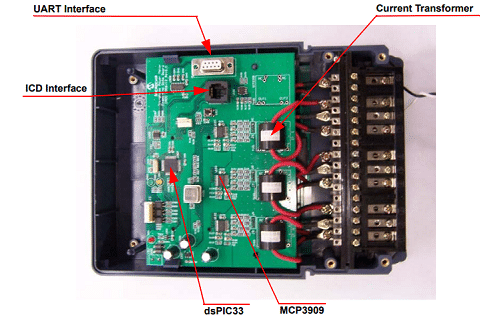The MCP3909 / dsPIC33F 3-phase energy meter reference design has an accuracy class of 0.2S
The energy meter reference design features active energy pulse output, active power, RMS current and voltage.

Energy meters are essential for detecting the usage of power and check the quality of incoming power. The newer meters not only measure the consumed power but also various other parameters such as frequency, RMS current, RMS voltage, etc. So, if you want to design your own power meter, then the 3-phase energy meter reference design from Microchip will simplify your job.
The MCP3909 / dsPIC33F is a reference design for a 3-Phase Energy Meter which is based on Microchip’s 16-bit dsPIC33F Microcontroller Unit (MCU). The reference design is capable of providing accurate measurements in a 220V, 5(10)A system. The design incorporates the MCP3909 16-bit ADCs for precise analog conversion, while the calculations are performed by a PIC18F2520 Flash MCU. The reference design includes the PIC18F4550 USB Interface Module, enabling meter evaluation and calibration using the “3-Phase Energy Meter Software” on Windows XP or Windows 2000. The module also features an LCD for additional energy meter firmware design and evaluation.
The reference design offers precise measurements and flexible output quantities, making it suitable for various meter designs, from basic energy meters to those requiring comprehensive harmonic analysis. The energy meter reference design can accurately measure active energy pulse output, active power, RMS current and voltage, and over 100 serially accessible output registers. Furthermore, it can enable you to measure voltage sag detection, and precise power calculations. The reference offers a robust platform for developing energy meters that meet stringent accuracy requirements. The integration of the dsPIC33F’s DSP engine and quasi-synchronous sampling algorithm results in cost savings and simplified meter design.
The MCP3909 3-Phase energy meter reference design offers a range of key features and advantages. It utilizes flash-based calculations for efficient energy measurement, employing wide dynamic range ADCs that ensure accurate analog conversion with 128 samples per line cycle. The meter offers calibration and correction registers for precise fine-tuning and user configurability. With its command-driven operation and mode registers, users can customize features like positive-only energy accumulation and no-load threshold mode. Additionally, the design includes the PIC18F4550 USB Interface Module for convenient meter evaluation and calibration using dedicated software, along with an LCD for firmware design and evaluation purposes. Overall, this reference design provides a comprehensive and user-friendly solution for robust 3-phase energy metering applications.
Key Features and Advantages of MCP3909 / dsPIC33F 3-Phase Energy Meter Reference Design
- DSP Engine and Fourier Transform: The design harnesses the dsPIC33F’s DSP engine, performing all calculations in the frequency domain using discrete fourier transforms (DFT). This allows for accurate harmonic analysis and various output quantities for different meter applications.
- Quasi-Synchronous Sampling Algorithm: The dsPIC firmware implements a quasi-synchronous sampling algorithm, eliminating the need for external zero-crossing detection and PLL circuitry. This reduces costs and complexity by synchronizing ADC samples to the line frequency through software-based frequency measurement and correction.
- High Accuracy and Performance: The meter design achieves an accuracy class of 0.2S, meeting stringent measurement requirements. It supports a wide range of parameters, including active power, reactive power, power factor, frequency, and harmonic component measurements for both voltage and current inputs.
- Flexible Meter Configuration: The design accommodates a 3-phase 4-wire system, with voltage inputs available for both 220/380V and 57.7/100V configurations. The ADC sampling rate is adjustable, providing flexibility for different sampling requirements.
- Pulse Outputs and Creeping Prevention: The meter includes two pulse outputs for total phase active power and reactive power. It features an anti-creeping design to ensure accurate measurement even at very low currents (<0.0008 IB). The pulse constant is set at 3200 Imp/kWh.
This reference design has been tested by Microchip. It comes with required design resources such as sample code, schematics, BoM, etc. You can find additional data about the reference design on the company’s website. To read more about this reference design click here.







DFT stands for Discrete Fourier Transform.